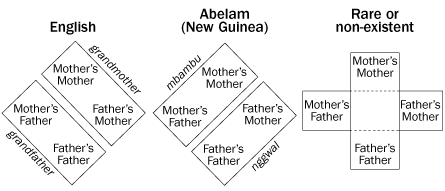Scientists may have found a couple of principles of relativity in family trees from different cultures.

Kin connections get defined in a dizzying number of ways from one language to another. But a new study, conducted by cognitive scientists Charles Kemp of Carnegie Mellon University in Pittsburgh and Terry Regier of the University of California, Berkeley, uncovers what may be universal rules of thumb for thinking about connections among relatives — and perhaps about other categories.
Terms used to describe kinship in languages from Africa to the Americas neatly balance between two opposing principles, Kemp and Regier report in the May 25 Science.
“Kinship systems achieve a near-perfect trade-off between simplicity and usefulness,” Kemp says.
Some languages veer more toward simplicity in defining kin relations, and others pack in more information, but not so much that each concern isn’t efficiently addressed, the researchers find in a new mathematical analysis of words describing family relationships.
The study shows that verbal communication places general limits on how people think about categories, including kin relationships, psycholinguist Stephen Levinson comments in the same issue of Science. Cultural forces, such as whether descent is traced through the mother’s or father’s side of the family, shape specific kin systems, adds Levinson, of the Max Planck Institute for Psycholinguistics in Nijmegen, Netherlands.
Simple yet informative terms work best for more concrete categories, such as kin relations and colors, remarks anthropologist Doug Jones of the University of Utah in Salt Lake City. Pairs of relatives, for instance, can be distinguished by distinctive features, such as sex for sisters and brothers. Single, distinguishing features can be tough to find for members of other categories, say for closely related animals such as deer and elk, Jones says.
Using complete sets of kin terms previously collected from 487 languages by another researcher, Kemp and Regier calculated that existing ways of communicating about kinship among speakers of different languages represent a tiny portion of possible ways to classify family relationships.
Based on the length of each language’s definitions for kin terms and the ability of those terms to specify intended individuals, the scientists calculate that cultures consistently devise words for various types of relatives that are fairly easy to understand but still informative. The balance between these principles typically tips in one direction or the other.
In English, for instance, the term “uncle” refers to a father’s brother, a mother’s brother, a mother’s sister’s husband and a father’s sister’s husband. In other languages, more intricate terminology for “uncle” conveys more specific information by denoting relatives only on the mother’s or the father’s side, sometimes over two or more generations.
Kemp and Regier plan to use their mathematical approach to examine whether color terms in different languages maximize listeners’ ability to identify hues similar to those intended by speakers.







